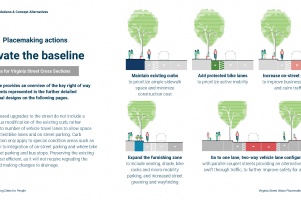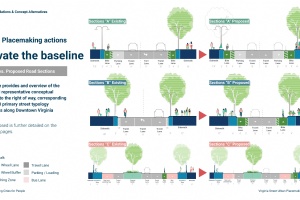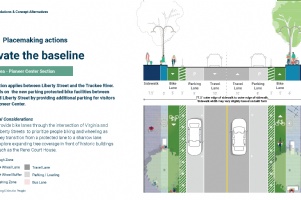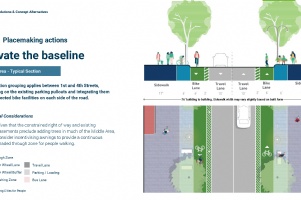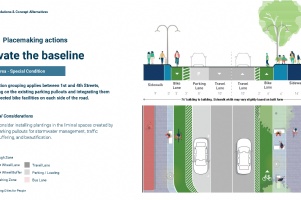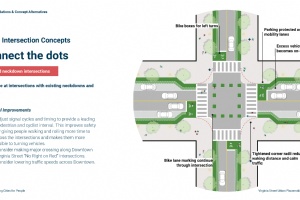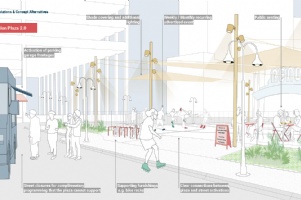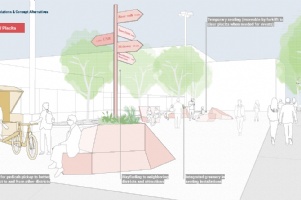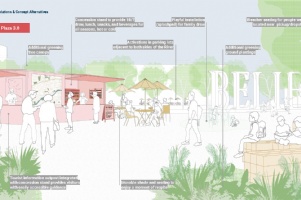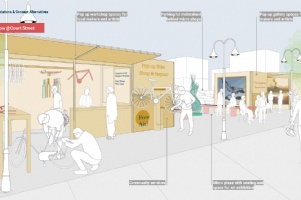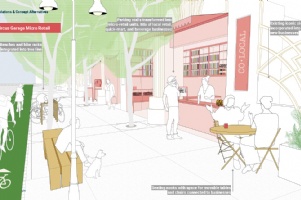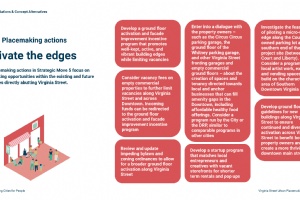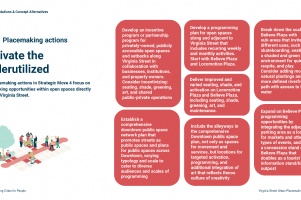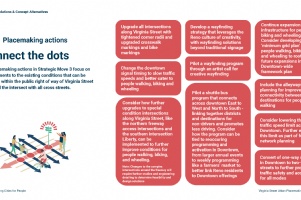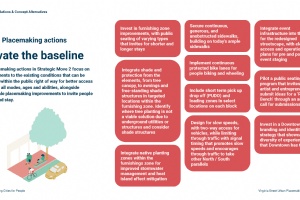Last week, Gehl presented their findings and design concepts in the final public meeting for the Virginia Street Placemaking Study project.
The placemaking study, as tasked, is reaching a conclusion. The findings and designs will be presented to the Reno City Council, and an implementation roadmap be put in place for the most feasible ideas.
For those not familiar, the Reno City Council last year initiated the process of conducting a placemaking study for Virginia Street between Liberty and 9th Street. Gehl was selected as the company to complete the study.
It’s no secret this area is an issue for downtown Reno, and Reno as a whole, and this was clearly laid out in the first part of the placemaking study, where a community survey laid out the honest truth on how Virginia Street is utilized by locals, and what we, as locals, think of it.
While 90% of those surveyed feel Virginia Street is critical to downtown Reno, a whopping 75% responded that Virginia Street lacks reasons for them to visit. Their own research yielded similarly grim stats, including that 70% of Virginia Street is fronted by inactive facades. People loved the history of Virginia Street, but felt there was a disconnect to that history and today. Gehl, shortly after their first public input meeting, then had several stakeholder meetings, which included the ‘Activators’ people who owned property and businesses fronting Virginia Street, and ‘Users’ who were a cross-section of citizens who used the areas, be it downtown workers, residents, or university students. Gehl then took the feedback presented in that public meeting, which was held on ZOOM and in person, and combined that data with the results of their second survey, and came back to the public on the 23rd to present these ideas.
Overall, four goals were created:
A. 18/7 Activation and Programming - This includes invitations to sit, rest and linger. High quality, inclusive intergenerational public spaces that offer a variety of amenities. A programming cadence that invites people to spend time on Virginia Street every day, all year, outside of special events, and a reinforced perception of safety.
B. Platform for Creativity and Innovation - Bring Reno’s culture of creativity and innovation to the street through incentives for local makers to create engaging installations and programming. Leverage iconic signage and facades with viewing platforms that spark curiosity and social connection, and celebrate historic alleyways by turning them into engaging public spaces
C. Enhanced connectivity and Climate - A well-defined identity that invites visitors from other districts and provides a sense of belonging for downtown residents. Create a walking experience with both direct connections and signage for leisurely strolls that invite discovery, and protection from the elements year-round
D. Local economic development - Focus economic growth on local entrepreneurship through bringing neighborhood amenities to within a 15-minute walk zone of downtown, and lower the barrier of entry for local entrepreneurs, with small-scale affordable commercial spaces.
These four goals then led into five strategic moves. They spent quite a bit of time summarizing each of these strategic moves, so I’m purely summarizing here:
1. Celebrate the character areas – Deliver context-responsive street design and programming that caters to the unique needs of the north, middle and south sections of Virginia Street downtown, which are all very different beasts. The Upper area being young entrepreneurs, UNR Students, health workers at St Marys, and Brewery District Tourists, the Middle being event goers, downtown residents, empty-nesters, sports enthusiasts (Reno Aces), and the Lower being local employees, civic and cultural workers, families and kids (at Wingfield), rafters, fishers, skaters etc. Gehl outlined the demographics of each section mentioned above, the draw of each section, and measures of success for each section.
2. Elevate the baseline – Make Virginia Street the downtown connector through a continuous street treatment, roadway redesign, and amplified placemaking. This includes investing in furnishing zone improvements (benches, art, etc), shade protection, implement continuous protected bike lanes through the corridor, include short-term pick-up/drop-off parking on each block, event infrastructure including electrical access.
3. Connect the Dots – Improve downtown’s connectivity for people walking and wheeling. Placemaking actions for this include – Upgrade all interactions along Virginia Street with tightened corner radii and upgraded crosswalk markings and bike markings, change downtown signal timing to slow traffic, develop a wayfinding strategy that leverages Reno culture with wayfinding solutions beyond traditional signage, convert one-way streets downtown to two-way streets, and a pilot shuttle bus program.
4. Activate the underutilized – Deliver placemaking improvements to setbacks, unbuilt lots and larger public spaces along Virginia Street. This includes developing an incentive program for privately owned, publicly-accessible spaces, develop programming plan for spaces, deliver improved seating shade and activation on Locomotion Plaza, pilot a concession stand on the Believe plaza, defining the river path with more access to the water.
5. Activate the edges – Improve the Virginia Street experience as a place for both locals and visitors, with improved access to existing businesses, activation of underutilized building edges, affordable food and beverage venues, local retail and other needed downtown amenities. 70% of the edges along Virginia Street downtown are inactive. Develop a ground floor activation and façade improvement incentive program, consider vacancy fees on empty commercial properties, review and update impeding bylaws or/and zoning ordinances to allow for a broader ground floor activation, working with hotels downtown to fill amenity gaps with property along Virginia Street and much more.
So that’s a quick summary of a 66-page presentation. You can download the presentation here as a PDF file to browse, which outlines in much greater detail the four goals and five placemaking action plans listed above. You can also watch the presentation here.
You can see images of some of the concepts below as well.
My Thoughts
Overall, as a comprehensive package, this will serve as a framework for the council to peruse and adopt. Many downtown residents, thousands who moved downtown from 2007 onward, have wanted something like this to happen for years. Then we have 20,000+ university students who, according to my nieces who are students and those who attended the Gehl focus group meetings, are told by student-advisers to avoid downtown south of Walgreens. Imagine if some minor and major tweaks to downtown create a corridor that appeals to university students, residents who have been waiting for some momentum along Virginia Street, and tourists who could take advantage of the amenities and ideas as well.
At the presentation by Gehl and the City, the audience seemed to universally accept the ideas of seating, shade, programming of the plazas, and installation of locally owned retail along Virginia to ‘Activate the Edges’.
I don’t disagree with any of the goals or ideas presented.
A couple of audience members asked how the City could help make this happen, and Revitalization Manager Bryan McArdle said a façade improvement program was back on the table, and that the City was looking at assisting pop-up spaces for a limited time. This is essentially how West Street Market got started. The City/Redev Agency leased the space, and offered the spaces initially at super low rates to help the first batch of tenants at WSM. But, the OG tenants suffered big time in the winter as there was not the resident base in 2009 that there is now.
Virginia Street
I may be in the minority, but I don’t believe in shutting down Virginia Street to traffic entirely, and neither does Gehl. I personally feel like Virginia Street first needs to prove itself as a standard ‘Main Street’ with two-way traffic and a bustling downtown retail center BEFORE it earns the reward of removing traffic entirely. Let’s get that 70% inactive-façade down a bit first.
Just a reminder that Midtown became a successful neighborhood years before the sidewalks were widened, trees planted and the street reconfigured. When I state successful, I’m referring to lack of vacant storefronts, activation, etc.
The most contentious piece of the presentation was the proposed reconfiguration of Virginia Street and…of course what it always comes down to….bike lanes. Or no bike lanes.
Virginia Street downtown recently underwent a ‘pilot program’ to explore different configurations for micro-mobility. Controversies of its birth aside, I wasn’t sure if Gehl incorporated any data from the pilot program/study into their designs for Virginia Street. You can see the configurations in the gallery below.
Gehl believes that bike lanes along Virginia Street are essential to accommodate all forms of downtown mobility, whether other streets have bike lanes or not. That was Gehl’s answer to Ky Plaskin from Reno Bicycle Alliance, when asked if Center Street would be a better viable option for micro-mobility transportation. Gehl also mentioned that bike lanes traveling in the direction of traffic on each side of the street is a better configuration than a two-way cycle-track, for Virginia Street.
Keep in mind these are also merely recommendations. The City Council has the option/ability to modify/reject/adopt any of these ideas.
Public Input
It was great to see such a cross-section of people in-person at this meeting. Long-time downtown property owner John Iliescu gave a passionate speech about the important of UNR connecting downtown and downtown accommodating UNR students, he felt like Gehl wasn’t incorporating that into their presentation.
Ky Plaskin questioned Gehl about the bike lanes, and whether it will truly form a single path through downtown without having to divert onto other streets, and whether the Center Street Cycle track was still in play.
Local historian and writer Alicia Barber wondered if more could be incorporated about Virginia Street’s history. Think Virginia City’s ‘Step back in Time’ campaign. Heritage tourism is a thing. Yes, Reno still attracts tourists (please look up the numbers before you go there) so let’s cater to multiple sectors of tourism, including historic wayfinding.
Even The Row had representatives in the audience watching.
Overall, I feel like it’s still headed in the right direction. Going forward, I’d say maybe customize the presentation to fit the unique needs of downtown a bit more? In chatting with other attendees, it was a general consensus it felt like a lot of the ideas were thrown into a general toolbox for The Council to pick out what tools they feel are relevant to us, rather than tell us/The Council what tools would work best given our downtown’s unique situation. A great example is the ‘convert one-way streets to two-way streets’ idea-bubble in the ‘Connect the Dots’ section. Is there data from RTC to support that?
I love all the ideas in the ‘Activate the Edges’ section the most. I feel those ideas resonate with Virginia Street’s issues and perceived issues the most.
You can download a PDF of the presentation and watch it online here. What are your thoughts?


